Summary:
The IBH stock market model is out of the market. The MAC stock market model is invested but the indicators may be rolling over, the bond market model avoids high beta (long) bonds despite them peaking today, the yield curve may be flattening, and gold and silver models are not invested. The recession indicator COMP is lower from last week’s level.
Stock-market:
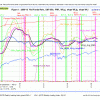 The IBH-model is out of the market as shown in Fig. 1.
The IBH-model is out of the market as shown in Fig. 1.
A sell signal was generated three weeks ago when the WLIg_shortEMA moved below the WLIg_longEMA. The WLI has lately not been very stable which is the reason for the frequent buy and sell signals since 2009. Two of the WLI components, M2 and the ratio 10-yr yield to Baa, seem to impair the WLI, as discussed in Why is M2 Still a Component of ECRI’s WLI? and Does ECRI’s WLI Remain a Usable Indicator?
However as noted in the M2 article, it would appear that the ECRI WLI may have stabilized since the end of 2012. Furthermore, we are in the process of developing our own Weekly Leading Index to replace the ECRI’s WLI in a recalibrated IBH model.
MAC Fig 2 shows the spreads of the moving averages, both being at approximately the same level as last week, but they may be in the process of forming a top (rolling over). The sell spread (red graph) has to move below the zero line for a sell signal
Bond-market:
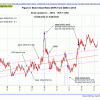 The BVR-model avoids high beta bonds (long-bonds) and also intermediate duration bonds.
The BVR-model avoids high beta bonds (long-bonds) and also intermediate duration bonds.
The Bond Value Ratio is shown in Fig 3. The BVR is significantly higher than last week, but the trend is downwards. In the longer term BVR will reach the long-term trendline and long-bond investors will have suffered considerable losses by then. This model was recently recalibrated to take the latest few months of data into account when calculating the best fit line. The upper and lower offset limit lines have been adjusted as well,
The Yield Curve:
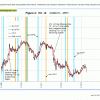 The yield curve model shows the steepening trend, but seems to be making an interim mini-top. Today’s dramatic drop of long bond yields is clearly visible.
The yield curve model shows the steepening trend, but seems to be making an interim mini-top. Today’s dramatic drop of long bond yields is clearly visible.
Figure 4 charts (i10 – i2). The trend is still up as one can see. FLAT and STPP are ETNs. STPP profits from a steepening yield curve and FLAT increases in value when the yield curve flattens. This model confirms the direction of the BVR
Recession:
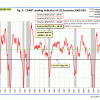 In Fig 5 one can see that COMP is more or less at the same level as last week. It is still far away from signaling recession.
In Fig 5 one can see that COMP is more or less at the same level as last week. It is still far away from signaling recession.
Comp can be used for stock market exit timing as discussed in this articleThe Use of Recession Indicators in Stock Market Timing.
Gold:
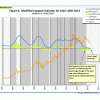 There is no buy-signal from the modified Coppock Gold indicator shown in Fig 6.
There is no buy-signal from the modified Coppock Gold indicator shown in Fig 6.
This model has been out of Gold since Nov-26-2012. Gold would have to make a sustained move to $1700 and higher over the next few weeks for a buy signal according to my projections. This indicator is described inIs it Time to Buy Gold Again? – Wait for the buy signal …….
Silver:
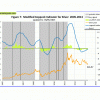 There is no buy-signal from the modified Coppock Silver indicator shown in Fig 7.
There is no buy-signal from the modified Coppock Silver indicator shown in Fig 7.
This model has been out of Silver since Apr-25-2011. This indicator is described inSilver – Better Than Gold: A Modified Coppock Indicator for Silver

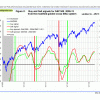
How much does IBH rely on ECRI WLI? If you feel WLI is no longer valid, is IBH no longer valid?
The ECRI-WLI is the main parameter for the IBH model. As mentioned in our M2 article the WLI may have stabilized late in 2012, thus the IBH model should be reasonably reliable for the time being. However, because of the potential volatility of the 10yr/Baa component we should expect surprises. We have constructed our own iM-WLI with superior characteristics in tracking the business cycle than the ECRI-WLI. Currently we are re-calibrating the IBH model to replace the ECRI-WLI with the iM-WLI.